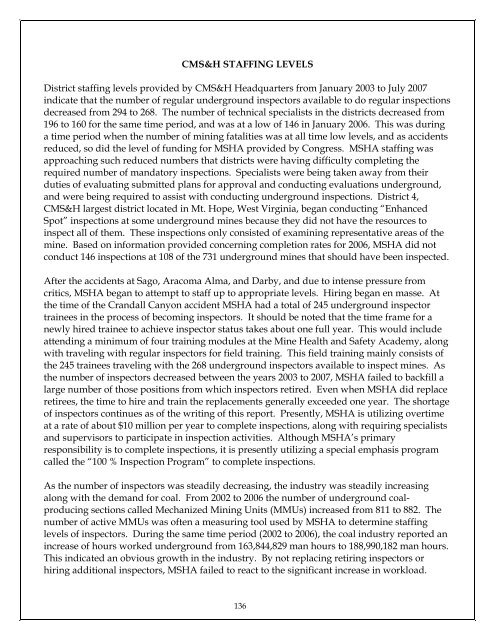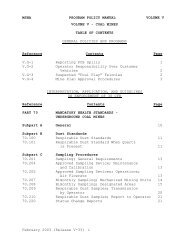Independent Review of MSHA's Actions at Crandall Canyon Mine
Independent Review of MSHA's Actions at Crandall Canyon Mine
Independent Review of MSHA's Actions at Crandall Canyon Mine
You also want an ePaper? Increase the reach of your titles
YUMPU automatically turns print PDFs into web optimized ePapers that Google loves.
CMS&H STAFFING LEVELS<br />
District staffing levels provided by CMS&H Headquarters from January 2003 to July 2007<br />
indic<strong>at</strong>e th<strong>at</strong> the number <strong>of</strong> regular underground inspectors available to do regular inspections<br />
decreased from 294 to 268. The number <strong>of</strong> technical specialists in the districts decreased from<br />
196 to 160 for the same time period, and was <strong>at</strong> a low <strong>of</strong> 146 in January 2006. This was during<br />
a time period when the number <strong>of</strong> mining f<strong>at</strong>alities was <strong>at</strong> all time low levels, and as accidents<br />
reduced, so did the level <strong>of</strong> funding for MSHA provided by Congress. MSHA staffing was<br />
approaching such reduced numbers th<strong>at</strong> districts were having difficulty completing the<br />
required number <strong>of</strong> mand<strong>at</strong>ory inspections. Specialists were being taken away from their<br />
duties <strong>of</strong> evalu<strong>at</strong>ing submitted plans for approval and conducting evalu<strong>at</strong>ions underground,<br />
and were being required to assist with conducting underground inspections. District 4,<br />
CMS&H largest district loc<strong>at</strong>ed in Mt. Hope, West Virginia, began conducting “Enhanced<br />
Spot” inspections <strong>at</strong> some underground mines because they did not have the resources to<br />
inspect all <strong>of</strong> them. These inspections only consisted <strong>of</strong> examining represent<strong>at</strong>ive areas <strong>of</strong> the<br />
mine. Based on inform<strong>at</strong>ion provided concerning completion r<strong>at</strong>es for 2006, MSHA did not<br />
conduct 146 inspections <strong>at</strong> 108 <strong>of</strong> the 731 underground mines th<strong>at</strong> should have been inspected.<br />
After the accidents <strong>at</strong> Sago, Aracoma Alma, and Darby, and due to intense pressure from<br />
critics, MSHA began to <strong>at</strong>tempt to staff up to appropri<strong>at</strong>e levels. Hiring began en masse. At<br />
the time <strong>of</strong> the <strong>Crandall</strong> <strong>Canyon</strong> accident MSHA had a total <strong>of</strong> 245 underground inspector<br />
trainees in the process <strong>of</strong> becoming inspectors. It should be noted th<strong>at</strong> the time frame for a<br />
newly hired trainee to achieve inspector st<strong>at</strong>us takes about one full year. This would include<br />
<strong>at</strong>tending a minimum <strong>of</strong> four training modules <strong>at</strong> the <strong>Mine</strong> Health and Safety Academy, along<br />
with traveling with regular inspectors for field training. This field training mainly consists <strong>of</strong><br />
the 245 trainees traveling with the 268 underground inspectors available to inspect mines. As<br />
the number <strong>of</strong> inspectors decreased between the years 2003 to 2007, MSHA failed to backfill a<br />
large number <strong>of</strong> those positions from which inspectors retired. Even when MSHA did replace<br />
retirees, the time to hire and train the replacements generally exceeded one year. The shortage<br />
<strong>of</strong> inspectors continues as <strong>of</strong> the writing <strong>of</strong> this report. Presently, MSHA is utilizing overtime<br />
<strong>at</strong> a r<strong>at</strong>e <strong>of</strong> about $10 million per year to complete inspections, along with requiring specialists<br />
and supervisors to particip<strong>at</strong>e in inspection activities. Although MSHA’s primary<br />
responsibility is to complete inspections, it is presently utilizing a special emphasis program<br />
called the “100 % Inspection Program” to complete inspections.<br />
As the number <strong>of</strong> inspectors was steadily decreasing, the industry was steadily increasing<br />
along with the demand for coal. From 2002 to 2006 the number <strong>of</strong> underground coalproducing<br />
sections called Mechanized Mining Units (MMUs) increased from 811 to 882. The<br />
number <strong>of</strong> active MMUs was <strong>of</strong>ten a measuring tool used by MSHA to determine staffing<br />
levels <strong>of</strong> inspectors. During the same time period (2002 to 2006), the coal industry reported an<br />
increase <strong>of</strong> hours worked underground from 163,844,829 man hours to 188,990,182 man hours.<br />
This indic<strong>at</strong>ed an obvious growth in the industry. By not replacing retiring inspectors or<br />
hiring additional inspectors, MSHA failed to react to the significant increase in workload.<br />
136

















